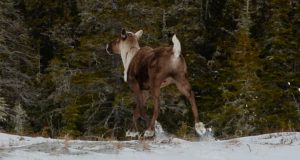Dec 22, 2017 @ 12:50
There have been moose and wolves on Isle Royale for many, many years. There have been woodland caribou and wolves on Michipicoten Island for a number of years too. Both islands have captive populations that are affected by ice bridges, and a finite ecosystem.
The Boreal Woodland Caribou were restored to Michipicoten Island in the mid-80’s by the Ontario Ministry of Natural Resources by flying caribou from the Slate Islands. These caribou had overpopulated the Slate Islands and were now damaging the vegatation (overbrowse). In a 2002 OMNR report it was stated that “The island habitat presents a predator-free environment for a number of prey species, specifically woodland caribou and beaver. Caribou may at times exist at a density of 7 to 11 per square kilometre, the highest densities in North America. In the absence of predators, the caribou populations have experienced a series of boom-bust cycles, the most recent bust having occurred during the winter of 1989-90, when caribou numbers fell from a high of 600 in the fall of 1989 to approximately 100 in the spring of 1990.” Another population crash occured in 2007-08 and the caribou population was described in 2012, likely to succumb to extirpation.
Studies have proven that predators, especially wolf in densities greater than 6.5/1,000 km2 may lead to a decline in woodland caribou populations (Bergerud, 1988). Studies conducted on woodland caribou populations (Horseranch) in British Columbia showed an 11% increase in the population in two years after wolf removal (Bergerud and Elliott 1998).
Agreeing with these studies is information from the Slate Islands. This caribou population existed for approximately 100 years without predation (OMNR 2011). During 1994 and 1995, when two grey wolves crossed the ice of Lake Superior during the 1993/1994 winter (Bergerud et al. 2007; Carr et al. 2012); the annual female adult survivorship declined from a historical mean of 82% to 71% in 1994 (Bergerud et al. 2007). The caribou population declined to approximately 100 individuals during this period.
The caribou enjoyed the space on Michipicoten Island (184 km²), which is almost three times larger than the Slate Islands (65.7 km²). Despite being slow to mature, and only dropping one calf a year; the caribou were doing well on Michipicoten Island growing to number 700 until wolves appeared on Michipicoten Island. Gord Eason who participated in the transfer from the Slate Islands is concerned. It has been esitmated that there are under 100 caribou on the island and that one of them is eaten every few days by one of the dozen wolves. The entire herd could be wiped by mid-January.
Looking at Isle Royale next, their moose population is exploding. Unfortunately the wolf population has not fared so well. From 1980 to 1996, canine parvovirus struck the wolves and probably was the major factor in a population crash that resulted in a decline from a historic high of 50 animals to 14 animals (Peterson 1999). A low level of genetic diversity (inbreeding) and low level of population growth is thought to leave the Isle Royale wolf population at risk of being extirpated within the park (Peterson 1999). Today there is said to be a lone female wolf on the island.
Plans are underway now to begin transferring Michipicoten Island Woodland Caribou back to the Slate Islands. This is a great idea returning them home. However, it may serve both islands, Michipicoten and Isle Royale to move the wolves instead. This transfer of the predator which is unwanted on Michipicoten and desperately need to control the moose population on Isle Royale may be the ideal answer. It would avoid any disturbance on behalf of the sensitive caribou, and allow them to rebound on Michipicoten Island. The transfer of wolves may be easier to conduct.
With the removal of the Michipicoten Island Caribou, one wonders what will happen to the wolves who will be left without their major food source.
- Monday Morning News – January 5 - January 5, 2026
- Winter Road Conditions & Weather – Monday, January 5th - January 5, 2026
- Hwy 17 (Montreal River Hill Area) Cleared - January 4, 2026
 Wawa-news.com Local and Regional News
Wawa-news.com Local and Regional News

Your hypothesis about moving the wolves has been discussed at length in numerous other articles and dismissed as a possibility in this case for a number of reasons. At the moment, it is more important to be encouraging the MNR to stop planning and actually do something as it is a very real possibility that the Caribou on Michipicoten might not make it through January.
NO!! Two islands should share their cervids. Isle Royale is a faux wilderness. Moose were introduced to the island by man and wolves may not have ever formed a breeding population if not for the release of wolves from the Detroit zoo in the 1950s.
When the moose population crashes again (it does every decade or so and much worse without predators) begin reintroducing caribou and removing the remaining invasive moose at the same time.
Between Isle Royale, The Slate Islands and Michipicoten a healthy, diverse meta population could exist to buffer the species against extinction.
Of course none of this matters if the MNR lets the rest of the caribou get killed off anyway.